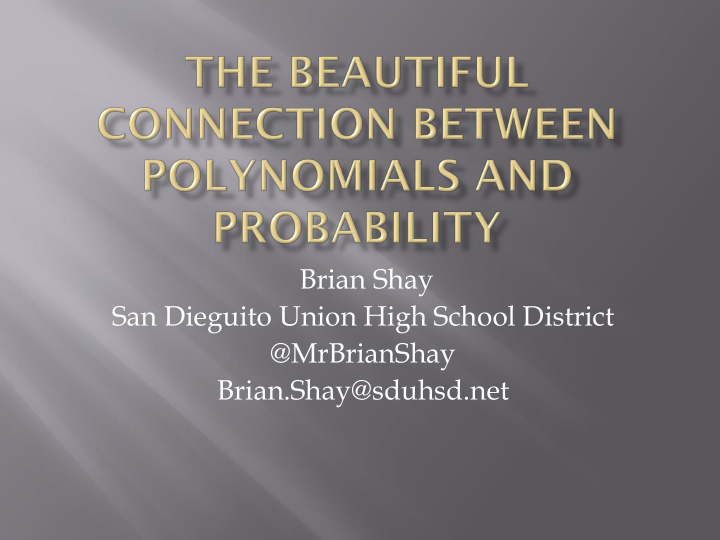



Brian Shay San Dieguito Union High School District @MrBrianShay Brian.Shay@sduhsd.net
Math Teacher and ToSA at Canyon Crest Academy, San Dieguito Union High SD High performing public school in San Diego Mentor with Math for America, San Diego Program committee chair/member for many CA and NCTM conferences Park City Math Institute Attendee Advocate for CCSS and its effective implementation
Experience classroom tested tasks Connect polynomial multiplication with probability Explore why this connection exists DO MATH! =)
In-Authentic polynomial tasks: Find the area of the rectangle with side length “x - 3” and “2x+1” The Probability Unit feeling disconnected to the rest of the course’s content Random Binomial Theorem tasks Find the coefficient of 𝑦 2 in the expansion of 𝑦 + 2𝑧 2 4 “Fake - World” Math…to quote my buddy Dan Meyer
Began at PCMI in 2012 Curiosity piqued by freshman multiplying polynomials with a “ punnett square” Lead to a PD I conducted with teachers in a neighboring district using CMP in 2015 Lead to a PD I conducted with teachers I mentor in 2015 Landed in my classroom and colleagues classrooms at my site in 2015 and 2016 Now at NCTM in 2016!
Warm up on polynomial multiplication Calculate theoretical probabilities Independent Events Coin flips Dice rolls Spinners Build polynomials for these probabilities Connect to Binomial Theorem Extrapolate a Trinomial Theorem and Pascal’s Tetrahedron
Which Math Practices are exhibited here? Which Mathematical Teaching Practices are being used? How to connect polynomial multiplication with probability? What questions might students have as they complete these tasks? Why does this connection work? Where this lesson could fit in your curriculum?
(𝑦 + 1) 2 (𝑦 + 𝑦 2 ) 2 (𝑦 + 𝑦 2 + 𝑦 3 ) 2 (𝑦 + 𝑦 2 ) 3
For each Head, you earn 1 point, while Tails earns you 2 points! Flip a coin twice. What options are there? What’s 1. the likelihood for each option? Now flip a coin three times and answer the same 2. questions. Do the same process with four flips. What patterns 3. do you notice? Why do you think these patterns are happening? What do you wonder will happen with five flips? 4. How about n flips?
What did you notice was happening with the probabilities and relationships? Why is this relationship happening?
Let’s now move up to a spinner. This spinner has three regions, each equal in size. The regions are labeled 1, 2, and 3. Spin twice and sum the results. What options are 1. there? What’s the likelihood for each option? Now do the same process with three spins and 2. answer the same questions. If we spun four times, what is the most likely sum 3. we would get? What might be an efficient way of tracking and calculating these probabilities?
What are some of the differences between the Coin problems and the Spinner problems? How are these two scenarios related? What surprised you as you worked through these questions?
What options are available when rolling two standard six-sided dice? How likely is each option? Expand: (𝑦 + 𝑦 2 + 𝑦 3 + 𝑦 4 + 𝑦 5 + 𝑦 6 ) 2 What relationships do you notice? Why are these related?
Instead of summing the values on the face of the dice, score yourself as follows: two points for rolling a multiple of three (3 or 6) and 1 point for not rolling a multiple of 3 (1, 2, 4, or 5).
Let’s now move back to a spinner. This spinner still has three equally sized regions, yet they are now labeled with the values 3, 4, and 7. Spin twice and sum the values. What options 1. are there? What’s the likelihood for each option? What would be the most likely sum if we spun 2. three times? What is the probability of getting this sum? How would you go about finding these 3. probabilities if we spun four times?
We go purchase a new spinner, pictured here on the right. If the spinner lands in Region A, you earn 1 point, if it lands in Region B, you earn 11 points, and if it lands in Region C, you earn 5 points. We spin twice and sum 2. What is the most likely sum 1. the points we earn. Find if the spinner is spun three the polynomial to times? represent this game. What is the most likely sum?
The variable can be thought as a place holder to preserve elements of structure Independent probabilities allow us to easily multiply and add probabilities without worry of overlap or dependencies Probabilities sum to one and one raised to any exponent is still one
Try these in your IM3 or Algebra 2 or Pre- Calculus classes Let me know how it goes @MrShayMath Brian.Shay@sduhsd.net NCTM Session #381
Recommend
More recommend